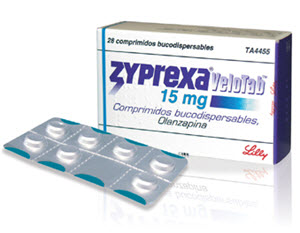 Type: Thienobenzodiazepine
Type: Thienobenzodiazepine
Active ingredient: Olanzapine
Common use: Zyprexa is an atypical (second generation) antipsychotic chiefly used to treat schizophrenia and bipolar disorder. When combined with fluoxetine it can also be used to treat resistant depression.
How to use: Zyprexa is available as tablets, intramuscular injection and wafer. (The wafer dissolves rapidly in saliva.) How to take Zyprexa depends on which type you have been prescribed.
How to store: How to store Zyprexa depends on if you have purchased tablets, wafers or intramuscular injection fluid. Follow the instructions from the manufacturer.
Warnings:
- The most common side-effect of Zyprexa is weight gain. Sometimes the weight gain is associated with derangement in the blood lipid and blood sugar profiles. Zyprexa can increase the risk of developing hyperglycemia and diabetes.
- In patients with diabetes mellitus, Zyprexa can produce non-trivial hyperglycemia.
- Dystonic reactions to Zyprexa are rare, but somewhat more common in young males than in other patient groups.
- Just like most other antipsychotics, Zyprexa may disrupt the body’s thermoregulatory systems.
- Olanzapine (the active ingredient in Zyprexa) is metabolized by the cytochrome P450 system. On average, over 40 percent of an oral dose will be removed by the hepatic first-pass effect. However, tobacco smoke and certain medications can significantly increase the hepatic first-pass clearance of olanzapine. There are also medicines, such as ciprofloxacin and fluvoxamine, that can reduce this clearance of olanzapine.
- Caution is warranted for elderly patients, especially those with dementia. In 2004, the UK Committee on the Safety of Medicines said that, due to the increased risk of stroke, olanzapine (the active ingredient in Zyprexa) should not be given to elderly patients with dementia. In the USA, olanzapine is not approved for use in patients with dementia-related psychosis.
- Even though Zyprexa is used to treat serious mental illness, it may – in a small subgroup of people – actually cause symptoms that are very similar to those brought on by serious mental illness, such as hallucinations, suicidal thoughts and behavior, and personality changes.
- It is unknown if Zyprexa is safe to use during pregnancy. It is also difficult to know which risks that come with the medicine itself and which risk that are only present when Zyprexa causes a significant weight gain.
- Breastfeeding while using Zyprexa is not recommended. Zyprexa is secreted in breast milk.
- Animal testing has showed an increased risk for cancer in female mice and rats chronically given olanzapine. The same effect was not seen in male mice and rats. The cancer tumors were found in the liver or in the mammary glands.
- Do not stop taking Zyprexa abruptly. A gradual withdrawal is recommended to decrease the risk of acute withdrawal syndrome or rapid relapse into illness. Examples of reported withdrawal symptoms are nausea, vomiting, dizziness, lightheadedness, tachycardia, nervousness, headache, diaphoresis, anxiety, dyskinesia, and orthostatic hypotension.
- Do not take more than the recommended dose of Zyprexa. Symptoms of overdose include dysarthria, tachycardia, agitation, decreased consciousness, coma and death. There is no known specific antidote for Zyprexa or other olanzapine medicines.
Examples of reported side-effects of olanzapine, the active ingredient in Zyprexa:
Very common (>10% incidence)
- Weight gain
- Somnolence
- Elevated blood levels of the hormone prolactine
- Elevated blood levels of cholesterol
- Elevated blood levels of glucose
Common (1-10% incidence)
- Oedema
- Restlessness / inability to stay still
- Tremor
- Muscle rigidity
- Reduced ability to move
- Reduced stability when standing, walking, etc
- Dyskinesia
- Extrapyramidal symptoms (EPS)
- Mild constipation at the onset of treatment
- Mild dryness of mouth at the onset of treatment
- Dizziness
- Glucose in the urine (as a consequence of hyperglycemia)
- Accidental injury
- Insomnia
- Weakness
- Fatigue
- Orthostatic hypotension
- Transient, asymptomatic elevations of the liver enzymes ALT and AST
- Dyspepsia
- Erectile dysfunction
- Decreased libido
- Rash
Uncommon (0.1-1% incidence)
- Low white blood cell count
- High creatine phosphokinase
- Increased total bilirubin
- Expulsion of milk from the breasts
- Breast enlargement
- Bradycardia
- Qtc interval prolongation
- Hair loss
- Urinary incontinence
- Inability to urinate
- Photosensitivity
- Cessation of a woman’s menstrual cycles
Rare (0.01-0.1% incidence)
- Rash
- Seizures
- Hepatitis
Very rare (<0.01% incidence)
- Jaundice (yellow discoloration of eyes, skin and mucous membranes due to liver problems)
- Painful and enduring erection
- Urinary hesitation
- Agranulocytosis
- Thrombocytopaenia
- Thromboembolism
- Rhabdomyolysis
- Increased alkaline phosphatase
- Pancreatitis
- Diabetic ketoacidosis
- Diabetic coma
- Neuroleptic malignant syndrome
- Anaphylactic reaction
- Sudden cardiac death
